From picture books to novels, stories in verse are popular with all age groups. Whether readers come to these stories for the content or for the poetry, they will find a focus on language and sensory images. This week’s collection of books includes rhyming and free verse stories, novels in verse, and a poetic biography.
Ages 4–8
Grump Groan Growl. bell hooks. Ill. by Chris Raschka. 2017. Disney-Hyperion.
 Hand-printed in India ink, the words of a spare rhyming text—“GRUMP / GROAN / GROWL / BAD MOOD / on the prowl”—explore what it feels like to be in a monstrously bad mood and how to work through it. Raschka uses the same bold ink technique and a colorful watercolor-washed background to create expressive images of the out-of-sorts curly-headed child and the fierce monster his bad mood creates to evoke a sense of anger, which lightens as the child calms down and controls the monster.
Hand-printed in India ink, the words of a spare rhyming text—“GRUMP / GROAN / GROWL / BAD MOOD / on the prowl”—explore what it feels like to be in a monstrously bad mood and how to work through it. Raschka uses the same bold ink technique and a colorful watercolor-washed background to create expressive images of the out-of-sorts curly-headed child and the fierce monster his bad mood creates to evoke a sense of anger, which lightens as the child calms down and controls the monster.
—JS
Nothing Rhymes with Orange. Adam Rex. 2017. Chronicle.
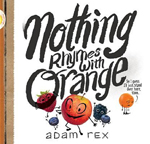 This hilarious book will delight readers with its rhymes and puns. Any child who enjoys hearing or writing original rhymes will laugh out loud at the playful text in which various fruits are paired with words that rhyme with their name. Examples include grapes/capes, kiwi/peewee, and cantaloupe/antelope. Rex’s marker-drawn faces on the fruit and use of messy lettering add to the fun of this story that ends with a satisfying twist.
This hilarious book will delight readers with its rhymes and puns. Any child who enjoys hearing or writing original rhymes will laugh out loud at the playful text in which various fruits are paired with words that rhyme with their name. Examples include grapes/capes, kiwi/peewee, and cantaloupe/antelope. Rex’s marker-drawn faces on the fruit and use of messy lettering add to the fun of this story that ends with a satisfying twist.
—LC
Watersong. Tim McCanna. 2017. Simon and Schuster.
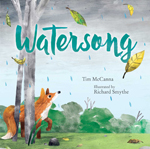 Dramatic double-page watercolor and digitally finished illustrations of a rainstorm in a forest habitat draw readers into this picture book, which begins with a “Drip / drop / plip / plop.” McCanna uses onomatopoeia to capture the changing sounds of the storm as a fox (visible in the illustrations but unmentioned in the text) makes its way through the forest. The text is set in the same font throughout the book, but size, color, and position of words vary on the page. For example, “spitter / spatter / splat” at the beginning of the storm is in smaller lettering than “POP! / Crash! / Whish! / Wash! / Wham!” at the height of the storm. In addition, the fox is positioned differently on each page to show how the storm affects the ecosystem as it moves through the forest back to its family. An appended “Listen to the Watersong” page features information and specific terms to guide children in thinking about the science behind the sounds explored in the story.
Dramatic double-page watercolor and digitally finished illustrations of a rainstorm in a forest habitat draw readers into this picture book, which begins with a “Drip / drop / plip / plop.” McCanna uses onomatopoeia to capture the changing sounds of the storm as a fox (visible in the illustrations but unmentioned in the text) makes its way through the forest. The text is set in the same font throughout the book, but size, color, and position of words vary on the page. For example, “spitter / spatter / splat” at the beginning of the storm is in smaller lettering than “POP! / Crash! / Whish! / Wash! / Wham!” at the height of the storm. In addition, the fox is positioned differently on each page to show how the storm affects the ecosystem as it moves through the forest back to its family. An appended “Listen to the Watersong” page features information and specific terms to guide children in thinking about the science behind the sounds explored in the story.
—LC
Ages 9–11
Before She Was Harriet. Lesa Cline-Ransome. Ill. James E. Ransome. 2017. Holiday House.
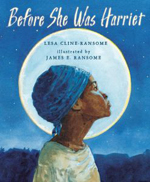 The story begins and ends with Harriet Tubman as an old woman. Each page walks readers through the life of this iconic American hero. “Before she was an old woman,” she was a suffragist; General Tubman, ferrying escaping slaves across a river; a Union spy; a nurse; Aunt Harriet, helping her parents fleeing to Canada; Moses, a conductor on the Underground Railroad; and Minty, a slave in Maryland. And before that, she was Araminta, “a young girl / taught by her father / to read / the woods / and the stars at night / readying / for the day / she’d leave behind / slavery / along with her name / and pick a new one / Harriet.” Astute readers will notice the similarities between the portrait style images on the first and last pages of James Ransome’s double-spread watercolor illustrations, which exquisitely convey Tubman’s character through detailed facial expressions and shifting perspectives. The free-verse text, written in the form of a cumulative tale, is engaging and describes the time period beautifully. Readers unfamiliar with Harriet Tubman will likely leave the book eager to learn more about her role in American history.
The story begins and ends with Harriet Tubman as an old woman. Each page walks readers through the life of this iconic American hero. “Before she was an old woman,” she was a suffragist; General Tubman, ferrying escaping slaves across a river; a Union spy; a nurse; Aunt Harriet, helping her parents fleeing to Canada; Moses, a conductor on the Underground Railroad; and Minty, a slave in Maryland. And before that, she was Araminta, “a young girl / taught by her father / to read / the woods / and the stars at night / readying / for the day / she’d leave behind / slavery / along with her name / and pick a new one / Harriet.” Astute readers will notice the similarities between the portrait style images on the first and last pages of James Ransome’s double-spread watercolor illustrations, which exquisitely convey Tubman’s character through detailed facial expressions and shifting perspectives. The free-verse text, written in the form of a cumulative tale, is engaging and describes the time period beautifully. Readers unfamiliar with Harriet Tubman will likely leave the book eager to learn more about her role in American history.
—LC
Tony. Ed Galing. Ill. Erin. E. Stead. 2017. Neal Porter/Roaring Brook.
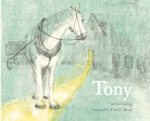 Caldecott Award-winning illustrator Erin Stead turns the short story poem “Tony” by Ed Galing (1917–2013) into a beautiful picture book that will appeal to young readers and horse lovers of all ages. The unseen narrator of the poetic verse rises at 3:00 am each morning to greet Tony, the strong, white work horse “with a ton of love” who pulls the milk wagon through town for young Tom, the milk deliverer. Soft pencil line drawings and muted shades of green and yellow create a sense of the breaking dawn as Tony begins his daily work in this warm and gentle story in verse.
Caldecott Award-winning illustrator Erin Stead turns the short story poem “Tony” by Ed Galing (1917–2013) into a beautiful picture book that will appeal to young readers and horse lovers of all ages. The unseen narrator of the poetic verse rises at 3:00 am each morning to greet Tony, the strong, white work horse “with a ton of love” who pulls the milk wagon through town for young Tom, the milk deliverer. Soft pencil line drawings and muted shades of green and yellow create a sense of the breaking dawn as Tony begins his daily work in this warm and gentle story in verse.
—JS
Ages 12–14
Stay. Katherine Lawrence. 2017. Coteau.
 This brief novel in verse captures a time of emotional intensity in the life of eleven-year-old Millie. Her parents are on the brink of divorce and she regularly visits the grave of her twin, who died at birth, seeking his advice in her struggles. Would a puppy make things better for her? Will her father move out? Does her mother really have a boyfriend? Readers will worry along with Millie and connect to aspects of her everyday life as well as her moments of crisis. In particular, they will relate to her reflections on her school friends and her relationship with her sister, Tara. For instance, when she and Tara find themselves spending weekends with their dad, Millie notes, “We’re not best friends, my sister and me, / But at Dad’s we share a bedroom, whisper.”
This brief novel in verse captures a time of emotional intensity in the life of eleven-year-old Millie. Her parents are on the brink of divorce and she regularly visits the grave of her twin, who died at birth, seeking his advice in her struggles. Would a puppy make things better for her? Will her father move out? Does her mother really have a boyfriend? Readers will worry along with Millie and connect to aspects of her everyday life as well as her moments of crisis. In particular, they will relate to her reflections on her school friends and her relationship with her sister, Tara. For instance, when she and Tara find themselves spending weekends with their dad, Millie notes, “We’re not best friends, my sister and me, / But at Dad’s we share a bedroom, whisper.”
—LC
Stone Mirrors: The Sculpture and Silence of Edmonia Lewis. Jeannine Atkins. 2017. Atheneum/Simon & Schuster.
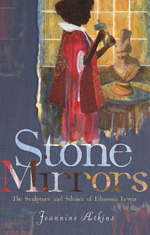 Edmonia Lewis (1844-1907), the daughter of an African-American father and an Ojibwe mother, became a respected sculptor in the 1800s, a time when female artists of color were not encouraged to create art. This fictionalized biography in free verse delves into different phases of the artist’s life. The book begins with Lewis’s exit from Oberlin College (where she is falsely accused of poisoning two school friends and suffers an assault by a group of men), moves to her time in Boston, and then to Rome where she studies as a sculptor, and ends with her eventual rise to fame. Back matter incudes a list of sources and an author’s note.
Edmonia Lewis (1844-1907), the daughter of an African-American father and an Ojibwe mother, became a respected sculptor in the 1800s, a time when female artists of color were not encouraged to create art. This fictionalized biography in free verse delves into different phases of the artist’s life. The book begins with Lewis’s exit from Oberlin College (where she is falsely accused of poisoning two school friends and suffers an assault by a group of men), moves to her time in Boston, and then to Rome where she studies as a sculptor, and ends with her eventual rise to fame. Back matter incudes a list of sources and an author’s note.
—JS
Ages 15+
Long Way Down. Jason Reynolds. 2017. Caitlyn Dlouhy/Atheneum/Simon & Schuster.
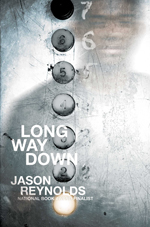 When his brother Shawn is shot and killed, fifteen-year-old Will sets out to follow the rules of the neighborhood: No Crying. No Snitching. Seek Revenge. He retrieves Shawn’s gun from its not-so-secret hiding spot and heads to the elevator to descend seven floors to the street. However, time slows down inside the elevator, and as it stops on every floor, a different ghost from the past who has been a part of the cycle of urban violence (including a childhood friend, his Uncle Mark, his father, and finally Shawn) joins Will and asks some hard questions about his plan. When the elevator reaches the ground floor, Will’s has made his decision. Or has he? The startling and disturbing imagery conveyed in Reynold’s free verse poems creates a beautifully-crafted novel to read and discuss.
When his brother Shawn is shot and killed, fifteen-year-old Will sets out to follow the rules of the neighborhood: No Crying. No Snitching. Seek Revenge. He retrieves Shawn’s gun from its not-so-secret hiding spot and heads to the elevator to descend seven floors to the street. However, time slows down inside the elevator, and as it stops on every floor, a different ghost from the past who has been a part of the cycle of urban violence (including a childhood friend, his Uncle Mark, his father, and finally Shawn) joins Will and asks some hard questions about his plan. When the elevator reaches the ground floor, Will’s has made his decision. Or has he? The startling and disturbing imagery conveyed in Reynold’s free verse poems creates a beautifully-crafted novel to read and discuss.
—JS
Solo. Kwame Alexander (with Mary Rand Hess). 2017. Blink/HarperCollins.
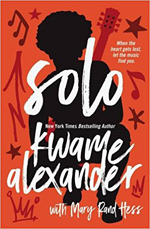 Seventeen-year-old Blade loves playing his guitar, and he loves his girlfriend, Chapel. But Blade’s larger-than-life, rock star father is an addict, his sister is a mess, and Blade finds himself marked as “guilty by association.” After finding out he’s adopted, Blade decides to take a solo journey to track down his birth mother in Africa. When Blade’s father shows up in the African village where Blade is staying, he can’t believe it and is sure that his father is going to ruin things for him once again. Told in verse novel-format and with Blade’s intermingled song lyrics, this story about family and finding oneself will resonate with teen readers.
Seventeen-year-old Blade loves playing his guitar, and he loves his girlfriend, Chapel. But Blade’s larger-than-life, rock star father is an addict, his sister is a mess, and Blade finds himself marked as “guilty by association.” After finding out he’s adopted, Blade decides to take a solo journey to track down his birth mother in Africa. When Blade’s father shows up in the African village where Blade is staying, he can’t believe it and is sure that his father is going to ruin things for him once again. Told in verse novel-format and with Blade’s intermingled song lyrics, this story about family and finding oneself will resonate with teen readers.
—JS
Jennifer W. Shettel is an associate professor at Millersville University of PA where she teaches undergraduate and graduate course in literacy for pre-service and practicing teachers. Prior to joining the faculty at Millersville, she spent 16 years as an elementary classroom teacher and reading specialist in the public schools.
Lesley Colabucci is an associate professor of early, middle, and exceptional education at Millersville University. She teaches classes in children’s literature at the graduate and undergraduate level. Her research interests include multicultural children’s literature and response to literature.
These reviews are submitted by members of the International Literacy Association's Children's Literature and Reading Special Interest Group (CL/R SIG) and are published weekly on Literacy Daily.